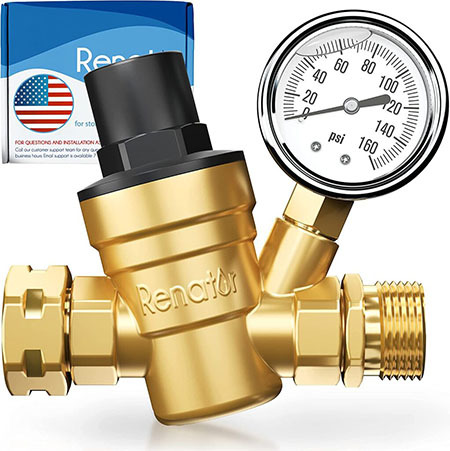Safe RV Water Pressure at Campgrounds - The Ultimate Guide (2025 Edition)
Posted by Happy Campers Store on Nov 18th 2025
The Ultimate Guide to Safe RV Water Pressure (2025 Edition)
The definitive guide to preventing leaks, blown fittings, bad showers, low-flow frustration, and black tank flushing issues — with safe PSI charts, regulator recommendations, and our full RV Water Pressure Database.
Learn the safe PSI range for RV water systems, prevent leaks, avoid blown fittings, compare regulators, and get our full RV Water Pressure Database.
Hooking up to city water looks simple: connect the hose, turn the spigot, and enjoy. But campground water systems vary wildly — from gentle 40 PSI to aggressive 100+ PSI spikes that can blow fittings, crack water heaters, and instantly destroy toilet valves.
This guide shows you everything you need to know: safe PSI levels, how regulators actually work, how to diagnose pressure issues, and the most complete RV water pressure database anywhere online.
Why RV Water Pressure Matters
RVs don’t use residential-grade plumbing. Pressure that’s normal in a house can overwhelm RV plumbing instantly. High PSI can cause:
- Leaks behind walls
- Blown faucet cartridges
- Toilet fill valve failure
- Water heater stress
- Bad black tank flushing
What Is a Safe PSI Range for Your RV?
Across brand manuals and technician guidance, the consensus is:
- Ideal everyday PSI: 45–50 PSI
- Comfort range: 40–55 PSI
- Avoid long-term: 60+ PSI
Even if a manual claims “up to 80 PSI,” that’s an absolute maximum rating — not a target operating range.
How to Use an RV Water Pressure Regulator
Always install the regulator directly at the spigot.
Two types exist:
- Fixed regulators: Cheap but low-flow
- Adjustable regulators with gauge: Best performance, accuracy & safety
How to Set It Properly
- Attach regulator to spigot
- Attach hose to regulator
- Attach hose to RV city-water inlet
- Turn on water slowly
- Adjust regulator to 45–50 PSI
Our Recommended RV Water Pressure Regulator (2025)

Renator M11-0660R — $26
- Adjustable up to 160 PSI
- Built-in pressure gauge
- Accurate fine-adjust control
- Heavy brass construction
- Protects RV plumbing from PSI spikes
More details: How to Choose the Best RV Water Pressure Regulator
Water Pressure vs Water Flow (Most RVers Confuse These!)
Pressure = force
Flow = volume
Flow suffers when:
- Campground plumbing is undersized
- Everyone showers at the same time
- Your hose or filters restrict flow
- Your regulator is clogged or old
Never Hook Up Without a Regulator If:
- You’re at an older park
- You’re at a new resort (80–120 PSI common)
- You hear water hammer
- Your hose vibrates
- You don’t know the local water source
- You see “flush hydrant testing” signs
Typical Campground Water Pressure by Region
- West Coast: 70–100+ PSI
- Southwest: Highest nationwide, 80–120 PSI
- Mountain West: 50–80 PSI
- Midwest: Stable 40–60 PSI
- Southeast: Often low, 30–50 PSI
- Gulf States: Wide range, 40–80 PSI
- Northeast: 30–50 PSI
Troubleshooting: Signs of High or Low Pressure
Too High:
- Toilet hissing
- Water hammer
- Hose bulging
- Gauge above 60 PSI
Too Low:
- Weak shower
- Pump cycles on city water
- Good pressure at the spigot but not inside RV
Proper Water Pressure Regulator Placement
Correct:
Spigot → Regulator → Hose → RV
Incorrect:
Spigot → Hose → Regulator → RV
Putting the regulator at the RV leaves the hose exposed to unregulated pressure — the #1 cause of hose failures.
Keystone RV
Recommended: 45–50 PSI
Comfort: 40–55 PSI
Most techs recommend staying under 55 PSI.
Forest River
Recommended: 45–50 PSI
Comfort: 40–55 PSI
Manuals warn about unpredictable park PSI.
Grand Design
Recommended: 45 PSI
Comfort: 40–55 PSI
Best balance reported at 45 PSI.
Jayco
Recommended: 45–50 PSI
Comfort: 40–55 PSI
Sensitive to pressure spikes; regulate carefully.
Winnebago
Recommended: 45 PSI
Comfort: 40–55 PSI
Mid-40s reduces fixture stress.
Airstream
Recommended: 45–50 PSI
Comfort: 40–55 PSI
PEX limits identical to other brands.
Lance
Recommended: 40–45 PSI
Comfort: 35–50 PSI
Shorter plumbing prefers lower PSI.
Tiffin
Recommended: 45–50 PSI
Comfort: 40–55 PSI
Residential fixtures still need regulation.
Newmar
Recommended: 45–50 PSI
Comfort: 40–55 PSI
Avoid long-term exposure above 60 PSI.
Alliance RV
Recommended: 45–50 PSI
Comfort: 40–55 PSI
High-PSI parks common; adjustable regulator ideal.
Coachmen
Recommended: 45 PSI
Comfort: 40–55 PSI
Safe universal mid-40s PSI.
Thor Motor Coach
Recommended: 45–50 PSI
Comfort: 40–55 PSI
Pressure spikes above 60 PSI can cause failures.
Unknown / Universal
Safe Default: 45 PSI
Comfort: 40–50 PSI
Ideal if your brand’s PSI isn’t listed.
Always verify PSI recommendations in your RV owner’s manual.
Printable Water Pressure Cheat Sheet
Download or share this infographic with RV friends and campgrounds:

Embed This Infographic on Your Website
RV Water Pressure FAQ
What PSI should I set my regulator to?
45–50 PSI is ideal for most RVs.
Is 60 PSI safe?
Short-term yes. Long-term: avoid it.
Do I need a regulator?
Yes — campground PSI can exceed 100 PSI unexpectedly.
Why is my shower weak?
This is usually a flow restriction issue, not PSI. Check filters, hose length, and campground plumbing.


